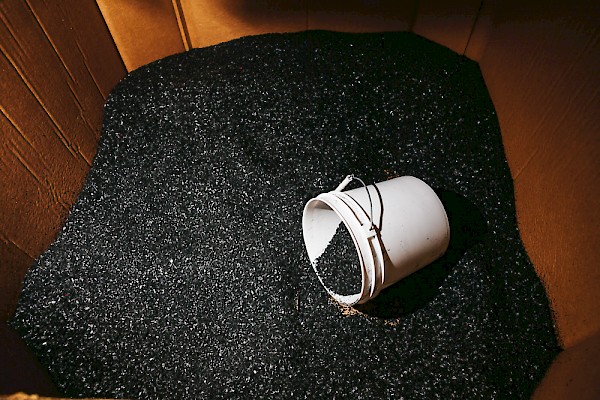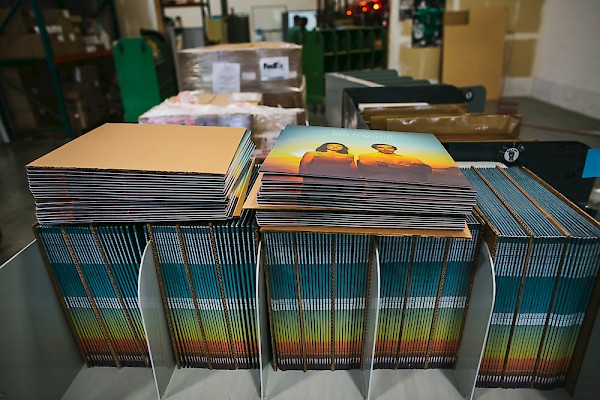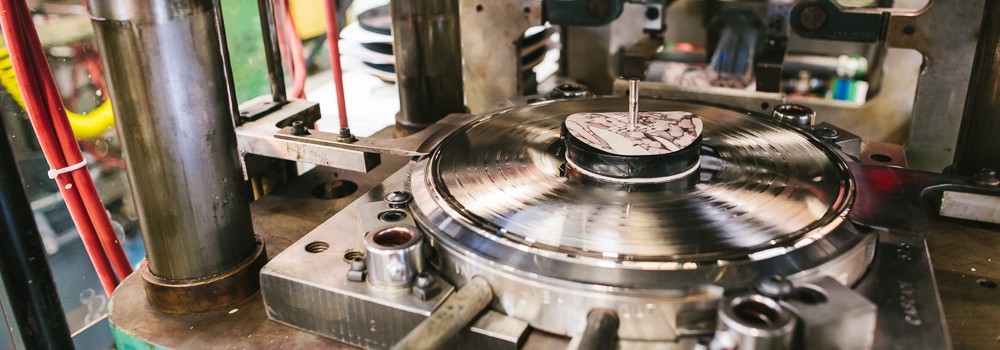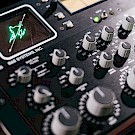 Steam-heated pellets become a hockey puck-esque biscuit. Pressed with the labels, stampers come together with 100,000 pounds of pressure and out pops a groove-filled record every 30 seconds—click to see a whole gallery of photos by Jason Quigley“In a perfect world, the process of a record being pressed is about a three-day cycle,” explains Cascade Record Pressing’s COO Mark Rainey:
Steam-heated pellets become a hockey puck-esque biscuit. Pressed with the labels, stampers come together with 100,000 pounds of pressure and out pops a groove-filled record every 30 seconds—click to see a whole gallery of photos by Jason Quigley“In a perfect world, the process of a record being pressed is about a three-day cycle,” explains Cascade Record Pressing’s COO Mark Rainey:
▶ First 24 hours: Labels are cured.
▶ Second 24 hours: Records are pressed and allowed to cure and cool overnight.
▶ Third 24 hours: Ready for assembly and dispatch.
Sounds simple enough, right? Well, the process is a manual, labor-intensive one with a lot of moving pieces—some of those are handled by professional engineers and press operators but others fall squarely on your plate if you’re interested in getting your music pressed on this aural analog format.
Located in a warehouse just outside of Portland, Milwaukie’s Cascade Record Pressing is Oregon’s first vinyl record pressing plant. The team started baking vinyl biscuits and pressing records in June, currently pumping out a vinyl record every 30 seconds—that’s some 25,000 per month while Cascade looks to increase its production capabilities as more presses come online and shifts are added to the workday. For the time being, the full-service vinyl manufacturing facility does one thing and focuses on doing it right: 150-gram or 180-gram, 12-inch vinyl pressed in black, custom or splattered colors.
Built with the aim of serving independent record labels and local artists, Cascade’s first customer was North Portland’s Mississippi Records and the first record out the door was a Dead Moon reissue. Supporting indies also means that Cascade fills an education role: Through good customer service and a serious emphasis on quality control, Cascade will walk the inexperienced through the vinyl pressing process and even offers useful online resources, from FAQs to downloadable design templates.
 From the hot press to cooling on spindles—click to see more photos by Jason QuigleyLocal artists can do a run as small as 500 records and pick it up themselves to save on shipping costs. It’ll take 10 to 12 weeks from test press approval to a finished, packaged product—if artists submit everything in a timely manner. So how’s it all work?
From the hot press to cooling on spindles—click to see more photos by Jason QuigleyLocal artists can do a run as small as 500 records and pick it up themselves to save on shipping costs. It’ll take 10 to 12 weeks from test press approval to a finished, packaged product—if artists submit everything in a timely manner. So how’s it all work?
Step 1: Mastering
Mastering is “the bridge between the artistic and the mechanical,” Rainey describes. You do this step on your own with a professional mastering engineer. Of course, Cascade recommends Portland’s Telegraph Mastering seeing as owner Adam Gonsalves is also a Cascade partner while his assistant, Amy Dragon, is the assistant plant manager. To go “from an artistic work to preparing physical manufacturing parts for mass production,” you must:
MASTER YOUR RECORDING SPECIFICALLY FOR VINYL: Compared to digital, there’s a much narrower scope of frequencies and physical space is limited (quality starts to suffer after 22 minutes per side)—watch Gonsalves and Josh Bonati tell you more about this process in an in-depth video at the end of this article.
CUT LACQUER: Also called an acetate disc, your mastering engineer will cut the first copy of your future record on a cutting lathe. Measuring 14 inches, there’ll be one for each side.
Step 2: PRESSING
From here on out, Cascade’s got your back.
 Lentil-sized PVC pellets are heated and formed into biscuits before being pressed into records—click to see more photos by Jason QuigleyPLATING: Due to a shortage of facilities and skilled workers, electroplating may be “the biggest bottleneck in the industry right now,” Rainey says. Good news? Cascade will handle the chemical process of turning your lacquer master into A and B side metal stampers.
Lentil-sized PVC pellets are heated and formed into biscuits before being pressed into records—click to see more photos by Jason QuigleyPLATING: Due to a shortage of facilities and skilled workers, electroplating may be “the biggest bottleneck in the industry right now,” Rainey says. Good news? Cascade will handle the chemical process of turning your lacquer master into A and B side metal stampers.
SETUP AND TEST PRESSING: Includes affixing the stampers, heating plastic pellets into biscuits, and preparing labels (which are actually oven-cured to remove any moisture), then pressing a few tests. Under no circumstances should you skip test presses! You’d want to know if your tracks are in the right order and playing at the right r.p.m. before you press a couple thousand, right?
PRESSING AND QUALITY CONTROL: Labels are inserted into the press with the plump biscuit, some 100,000 pounds of pressure is applied, and out comes a record roughly every 30 seconds. The machine drops 50 records onto a spindle before Cascade pulls the stack and visually inspects every vinyl and sonically checks 10 percent of the entire run.
Step 3: PRINTING & PACKAGING
While you’ve surely given plenty of thought to your album’s cover, printing these assets must happen before Cascade will even consider pressing your record. You can do packaging design (using downloadable templates on Cascade’s website) and printing yourself, or you can allow Cascade to coordinate the process. What’s needed:
 Alela Diane & Ryan Francesconi's just-released 'Cold Moon' on vinyl—click to see more photos by Jason QuigleySTOCK SLEEVES AND JACKETS: Cascade can provide plain unprinted sleeves and white or black jackets but will not release a record without a sleeve.
Alela Diane & Ryan Francesconi's just-released 'Cold Moon' on vinyl—click to see more photos by Jason QuigleySTOCK SLEEVES AND JACKETS: Cascade can provide plain unprinted sleeves and white or black jackets but will not release a record without a sleeve.
CUSTOM PRINTING: From labels to jackets and other inserts (like download cards), you can DIY the project or work with Cascade “who can pretty much provide whatever you can come up,” Rainey says.
FINAL PACKAGING: From no plastic wrap to shrink to a reusable polybag, you pick.
ASSEMBLY AND SHIPPING: Put it all together and, if you’re in Portland, you can simply pick it up yourself!










